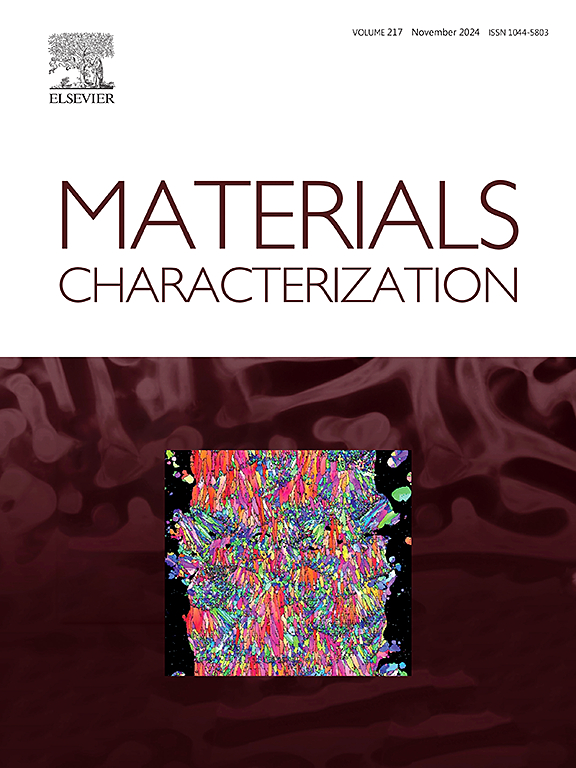Mo含量对(CoNi)80-xCr10Fe10Mox多主元素合金组织和力学性能的影响
IF 4.8
2区 材料科学
Q1 MATERIALS SCIENCE, CHARACTERIZATION & TESTING
引用次数: 0
摘要
在多主元素合金(mpea)领域,开发具有优化强度塑性平衡的面心立方(FCC)结构合金仍然是一个关键的挑战。本研究系统探讨了Mo含量对(CoNi)80-xCr10Fe10Mox合金组织和力学性能的影响。随着Mo含量的增加,合金由单相结构转变为双相结构。同时,层错能从C-Mo5的20.25 mJ/m2降低到C-Mo13的19.62 mJ/m2。热处理后,A-Mo13中μ相沿晶界析出,提高了合金的抗拉强度。与单相A-Mo9合金相比,A-Mo13合金的抗拉强度提高了300 MPa,塑性损失仅为8%。复合强化机制主要包括晶粒细化和第二相强化。通过热处理和μ相析出的协同作用,FCC晶粒由150 μm细化到7.4 μm。同时,富mo相作为坚硬的第二相,阻碍位错运动,改变裂纹扩展路径,从而提高了拉伸强度,保持了良好的塑性。本研究结果为FCC mpea的强化提供了有价值的理论和实践见解。本文章由计算机程序翻译,如有差异,请以英文原文为准。
Effect of Mo content on the microstructure and mechanical properties of (CoNi)80-xCr10Fe10Mox multi principal element alloys
In the field of multi-principal element alloys (MPEAs), developing face-centered cubic (FCC) structured alloys with optimized strength-plasticity balance remains a critical challenge. This study systematically explores the impact of Mo content on the microstructure and mechanical properties of (CoNi)80-xCr10Fe10Mox alloys. With increasing Mo content, the alloy changes from a single phase to a dual phase structure. At the same time, the stacking fault energy decreases from 20.25 mJ/m2 of C-Mo5 to 19.62 mJ/m2 of C-Mo13. After thermomechanical processing, μ phase precipitates along grain boundaries in A-Mo13, which enhances the tensile strength of the alloy. Compared with the single-phase A-Mo9 alloy, the tensile strength of the A-Mo13 alloy increases by 300 MPa, with only an 8% loss in plasticity. The combined strengthening mechanisms primarily include grain refinement and second phase strengthening. Through the synergistic effects of thermo-mechanical treatment and μ-phase precipitation, the FCC grains were refined from 150 μm to 7.4 μm. Simultaneously, as a hard second phase, the Mo-rich phase impedes dislocation movement and alters the crack propagation path, thus improving the tensile strength and maintaining good plasticity. The findings of this study provide valuable theoretical and practical insights for the strengthening of FCC MPEAs.
求助全文
通过发布文献求助,成功后即可免费获取论文全文。
去求助
来源期刊

Materials Characterization
工程技术-材料科学:表征与测试
CiteScore
7.60
自引率
8.50%
发文量
746
审稿时长
36 days
期刊介绍:
Materials Characterization features original articles and state-of-the-art reviews on theoretical and practical aspects of the structure and behaviour of materials.
The Journal focuses on all characterization techniques, including all forms of microscopy (light, electron, acoustic, etc.,) and analysis (especially microanalysis and surface analytical techniques). Developments in both this wide range of techniques and their application to the quantification of the microstructure of materials are essential facets of the Journal.
The Journal provides the Materials Scientist/Engineer with up-to-date information on many types of materials with an underlying theme of explaining the behavior of materials using novel approaches. Materials covered by the journal include:
Metals & Alloys
Ceramics
Nanomaterials
Biomedical materials
Optical materials
Composites
Natural Materials.
 求助内容:
求助内容: 应助结果提醒方式:
应助结果提醒方式:


